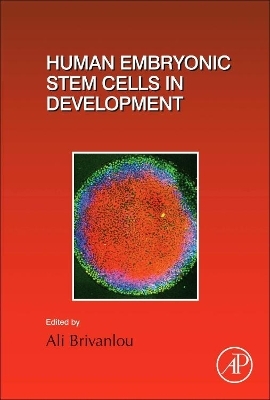
Human Embryonic Stem Cells in Development
Academic Press Inc (Verlag)
978-0-12-804251-9 (ISBN)
Dr. Brivanlou received his doctoral degree in 1990 from the University of California, Berkeley. He joined Rockefeller in 1994 as assistant professor after postdoctoral work in Douglas Melton’s lab at Harvard University. Among his many awards are the Irma T. Hirschl/ Monique Weill-Caulier Trusts Career Scientist Award, the Searle Scholar Award, the James A. Shannon Director’s Award from the NIH and the Presidential Early Career Award for Scientists and Engineers. The Brivanlou laboratory has demonstrated that the TGF-ß pathway plays a central role in inductive interactions leading to the establishment of different neural fates, which begins by the specification of the brain. In studies of frog embryos, Dr. Brivanlou has made several influential discoveries, including the finding that all embryonic cells will develop into nerve cells unless they receive signals directing them toward another fate. A concept, coined “the default model of neural induction, postulates that neural fate determination requires the inhibition of an inhibitory signal. His laboratory has contributed to the molecular and biochemical understanding of the TGF-ß signaling pathway and cross talk with other signaling networks, using comparative studies of frog and mouse embryos and mammalian cell culture. To address whether the default model of neural induction is conserved from amphibians to mammals (and humans in particular), Dr. Brivanlou’s laboratory was among the first to work directly in hESCs. Dr. Brivanlou and colleagues derived several hESC lines, called RUES1, 2 and 3 (Rockefeller University Embryonic Stem Cell Lines 1, 2 and 3). The RUES lines were among the first 13 hESC lines approved for use in research funded by the National Institutes of Health (NIH), under the NIH Guidelines for Human Stem Cell Research adopted in July 2009 under the Obama administration. Their current work focuses on the molecular dissection of the defining properties of ESCs — their capacity for self-renewal and their ability to differentiate into a range of cell types. Dr. Brivanlou’s overall goal is to use hESCs to study early human embryonic development. Several collaborations with Rockefeller University physics laboratories have provided new insight, from the use of quantum dots for in vivo embryonic imaging (with Albert J. Libchaber) to development of new statistical tools for DNA microarray and high throughput proteomic analysis. Ongoing collaboration with Rockefeller’s Eric D. Siggia focuses on using a high throughput microfluidic platform to program hESC differentiation toward specific fates by dynamic changes of the signaling landscape and without compromising genetic integrity. Thus, the first steps of stem cell differentiation are being scrutinized using new high-resolution techniques drawn from physics. This data will be organized and developed into a predictive tool to rationally reprogram specialized fates from hESCs.
1. Modeling Mammalian Gastrulation With Embryonic Stem Cells Eric D. Siggia and Aryeh Warmflash 2. What Can Stem Cell Models Tell Us About Human Germ Cell Biology? Naoko Irie, Anastasiya Sybirna and M. Azim Surani 3. From Human Pluripotent Stem Cells to Cortical Circuits Marc Astick and Pierre Vanderhaeghen 4. Studying the Brain in a Dish: 3D Cell Culture Models of Human Brain Development and Disease Juliana Brown, Giorgia Quadrato and Paola Arlotta 5. The Long Road to Making Muscle In Vitro Olivier Pourquié, Ziad Al Tanoury and Jérome Chal 6. Recapitulating and Deciphering Human Pancreas Development From Human Pluripotent Stem Cells in a Dish Maja B.K. Petersen, Carla A.C. Gonçalves, Yung H. Kim and Anne Grapin-Botton
| Erscheinungsdatum | 04.08.2018 |
|---|---|
| Reihe/Serie | Current Topics in Developmental Biology |
| Verlagsort | San Diego |
| Sprache | englisch |
| Maße | 152 x 229 mm |
| Gewicht | 520 g |
| Themenwelt | Medizin / Pharmazie ► Physiotherapie / Ergotherapie ► Orthopädie |
| Naturwissenschaften ► Biologie ► Genetik / Molekularbiologie | |
| Naturwissenschaften ► Biologie ► Zellbiologie | |
| Technik ► Medizintechnik | |
| ISBN-10 | 0-12-804251-6 / 0128042516 |
| ISBN-13 | 978-0-12-804251-9 / 9780128042519 |
| Zustand | Neuware |
| Haben Sie eine Frage zum Produkt? |
aus dem Bereich


